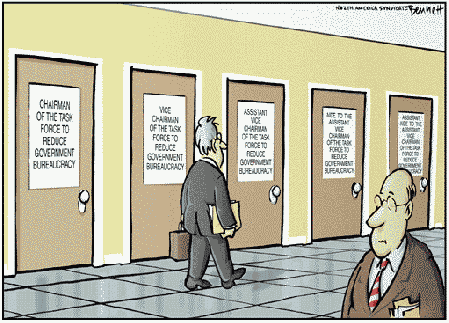What to Do? – Part III
Since FDR’s New Deal, the general government in Washington has grown into an insufferable Medusa. To “slay” this “Medusa” (and no, I’m not suggesting destroying our government) so that it becomes the small, constitutionally limited government it was created to be will require more than just stopping spending (What to Do – Part I) and eliminating unconstitutional and overlapping agencies that have been created over the past 70 years (What to Do – Part II) .
To rein in these agencies we must get to the source of the power these agencies have over our lives, namely the repeal of the Administrative Procedure Act of 1946. You may not have heard of this legislation, but it was what gave life to the regulatory, enforcement and adjudication powers of these myriad agencies that we seek to eliminate. The Act provides the procedural guidelines that all agencies are expected to follow in two major areas – rulemaking (which is nothing more than legislating) and adjudication (which is simply rendering judicial decisions regarding the rules they have promulgated). The Act requires that public notice be given for public comment and input before implementing any proposed new regulation, and Congress, by the passage of a joint resolution, has the authority to disapprove any such proposed rule within 60 days of its finalization.
There are several problems with this Act which should make any constitutionally-minded member of Congress eager to support its repeal. First and foremost, it is the very embodiment of James Madison’s definition of tyranny:
“The accumulation of all powers, legislative, executive, and judiciary, in the same hands, whether of one, a few, or many, and whether hereditary, self-appointed, or elective, may justly be pronounced the very definition of tyranny…the preservation of liberty requires that the three great departments of power should be separate and distinct” (The Federalist Papers, No. 47).
As pointed out above, in passing the APA Congress granted all three of these powers into the hands of these agencies.
Second, as these regulations are given the standing of law, enforced as law, and we are judged against them as though they are law, the Act violates the Constitution and thereby should have been stricken down before the ink of President Truman’s signature on it had dried. Article I Section 1 of the Constitution begins by stating that “All legislative Powers herein granted shall be vested in a Congress of the United States”. Article II Section 1 begins “The executive Power shall be vested in a President of the United States of America.” Article III Section 1 similarly leads off by stating “The judicial Power of the United States, shall be vested in one supreme Court, and in such inferior Courts as the Congress may from time to time ordain and establish.” The language in these three sections are very clear – in no wise are these powers to be shared between the three branches or some other entity, period! For these agencies to hold all three powers indisputably places them in violation of the Constitution.
Third, as far as public notice and Congressional review goes, consider these facts. In 2014 alone the Obama Administration issued 75,000 pages of new regulations. In the first three days of 2014, the Feds released 141 new regulations, and since Obama became president there have been 21,000 new regulations issued as of December 2014. What citizen, much less representative or senator, can possibly have time to review such a mountain of rules?
So here is the next step in the process of reducing spending and cutting our government back to its constitutional limits: repeal of the APA, return the responsibility of legislative action to the Congress, and either pass real legislation revoking the unconstitutionally created regulations these agencies have created over the years or simply proclaim them to no longer be in force as they were not law to begin with. That will be a huge task to accomplish, but again, freedom and the restoration of our liberties is worth the effort.



